An interview with comedian Julian Torres and 3D animator Julian Glander.
The Children’s Book Review
In this episode, I talk with the awesome duo Julio Torres and Julian Glander, creators of the picture book I Want to Be a Vase. This book makes for a dynamic and important conversation starter with its themes of confidence and embracing one’s true identity.
Julio Torres is a comedian, the creator of the HBO special My Favorite Shapes, and has written for Saturday Night Live. He’s also one of the masterminds behind Los Espookys, HBO’s Spanish-language comedy about a group of horror enthusiasts.
Julian Glander is a 3D animator, designer, and illustrator. Mostly self-taught, he has created work for Disney, Cartoon Network, Nickelodeon, Adult Swim, and The New York Times. He is also the creator of the video game Art Sqool and the squishy comics collection 3D Sweeties.
Listen to the Interview
Discussion Topics:
- About I Want to Be a Vase and how it came to be a book.
- Julio Torres talks about being who you want to be and bringing kids into this conversation.
- A discussion on Julian Glander’s uncanny 3D artwork.
- Celebrating the uniqueness of others.
- Breaking the typical book character mold.
- Julio’s path to becoming a comedian.
- Julian’s path to becoming an animator.
- Guidance counselor humor.
- The difference between writing a Saturday Night Live sketch versus a children’s book.
- Julio Torres and Julian Glander’s hopes for I Want to Be a Vase.
Read the Interview
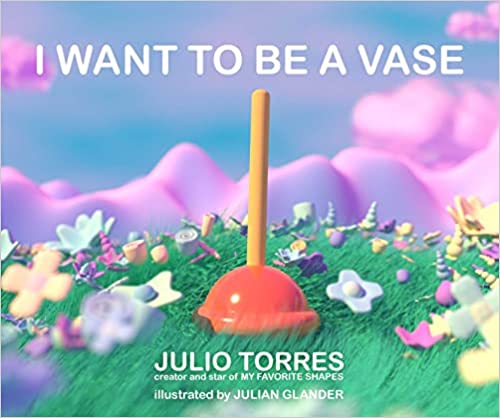
Bianca Schulze: Julio and Julian, welcome to the Growing Reader’s Podcast. I am beyond excited to talk about your book I Want to Be a Vase. I don’t even know where to start with this one because it is the coolest, wackiest picture book out there that delivers on inclusivity, confidence, and embracing one’s true identity—not to mention that you had me with the plunger on the front cover. So, Julio, since I Want to Be a Vase, is inspired by your clever HBO special, My Favorite Shapes. Do you want to kick us off by sharing the how and the why this book came about?
Julio Torres: Sure! An editor reached out and asked if I wanted to write a children’s book based on that HBO special. And it took a little bit for me to wrap my mind around it because, in the special, I thought that a lot of the humor came from how unexpected it was to show toys to adults in the context of an HBO standup special. But then when I was thinking about a kid’s book, I thought that like, well, but then showing like cute little characters to kids is expected. So, then I thought, what is the most unlikely hero for a kids’ book? And then I thought about a plunger.
Bianca Schulze: I love it. Well, since there’s clearly a fascination for shapes here and inanimate objects, the 3D artwork that you created, Julian, is honestly the perfect pairing. It’s vibrant and plucky and brings exactly the right energy to Julio’s words. So, what was it about Julio’s story that made you say yes to creating the artwork for this project?
Julian Glander: Yeah. I had been a fan of Julio’s for a long time when My Favorite Shapes came out. Like everyone I knew was texting me, emailing me, like, you have to watch this. This guy has read your mind—like, this is exactly what you’re about. So, I had been a fan.
And when I got the manuscript for it, I think the thing that I really liked was that it was written almost like a movie or a TV episode or something. These were like stage directions, like the camera moves left, or we zoom in. Things that you can’t really even do in a picture book. And I thought that was so exciting and cool because my background is in animation—and that’s how I think anyway. And yeah, like the manuscript had all these things that felt like little challenges to me. And Julio had already decided all these really crazy rules, like, we’re not going to do any faces. We want to play with light. He wanted to do all the things I was interested in doing, and I had to say, yes, I was so lucky to get reached out to on this one.
Bianca Schulze: Yeah. I love that you mentioned that there weren’t any faces. And Julio, that’s such a great rule that you created, because that’s one of the things that I absolutely loved, is that it’s unexpected. And while there are no faces, which a lot of illustrators and animators use to create the energy and the mood of characters, it wasn’t even needed. You still got the mood just from the dialogue between the characters. So, I’m really glad that you mentioned that, Julian.
Okay, so we have a plunger as the main character, an intrepid plunger who wants to be a vase and therefore becomes a vase. Let’s talk about the vacuum because Vacuum is a bit of a naysayer and is fixated on predestined roles. So, what do you want us to know about vacuums, persona, Julio?
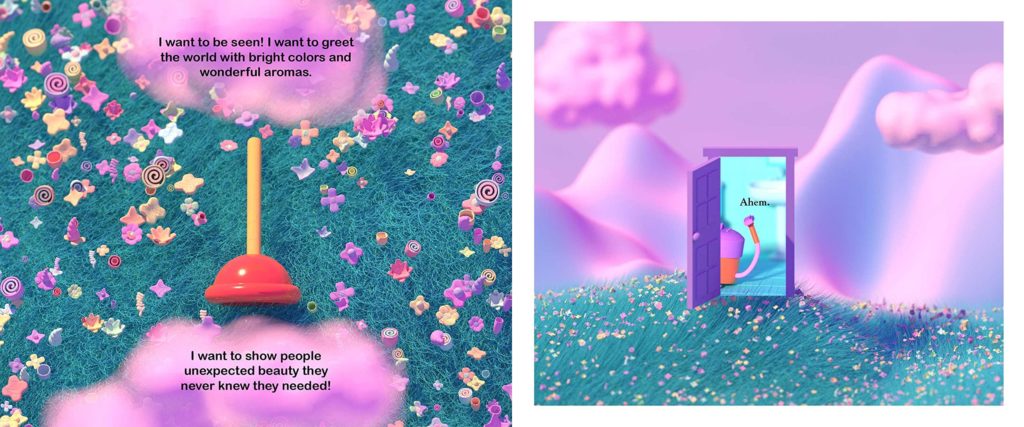
Julio Torres: Well, I thought about Vacuum because it’s, it seems like if you’re an object that is one of the most cutthroat industries to be an object in, because vacuums are always measured in their efficiency and are—like, there’s always a new vacuum out there that does things better. So, if you’re a vacuum, sort of like in the way that toothbrushes are. Like advertisement—it’s always like: Forget about your old, stupid toothbrush. That’s a stupid, bad toothbrush you have. Get a new one. Better. And it felt like vacuum cleaners are always, like, on the verge of being fired. So, they’re always sort of like—I felt like if vacuum cleaners had souls, they would be very territorial.
And in working with this book, I thought a lot about labor and the boxes that we’re put in and, what we’re supposed to do, what we’re not supposed to do. I also didn’t want to create a quote-unquote villain that was just a villain, but a naysayer that was very much informed by very real anxieties that very real people have. And I think that this feeling around us that some people have of we can’t let others be who they want to be because then it’s a slippery slope for us. Being displaced is a very real fear that I think should be engaged with.
Bianca Schulze: Yeah.
Julio Torres: And I think that in the way that there are imaginative, sensitive kids out there that want to be vases—there are plungers that don’t want to be vases. There’s also kids out there for whom the world works perfectly fine. And they may be a little uncomfortable with kids that want to be vases. And I think that those kids need to be brought into the conversation as well, which is why that character exists.
Bianca Schulze: Yeah. And I love that Vacuum has a little bit of growth in there, of, you know, accepting that others are different from Vacuum’s perception of life. And even though there’s growth at the very end, Vacuum is still Vacuum. And I think that that’s exactly what you intended and it’s exactly what comes across.
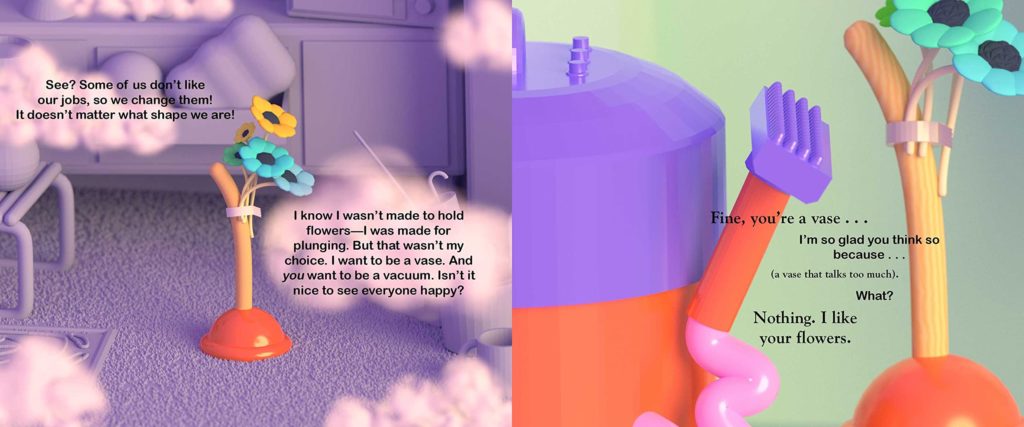
So, I would love it if each of you would share a highlight from the book, like maybe a favorite line from the text or a specific illustration. I’m assuming you both have a moment from the book that perhaps speaks to you each. And Julian, do you want to go first?
Julian Glander: I will go first. I’m flipping through it right now because I knew you were going to ask this and it is really hard to pick. I do think my favorite is the sort of dream sequence where the plunger is imagining itself in a field. And what we were trying to do is like, I think Julio called it like a field from a medicine commercial, like allergy medicine commercial. And there’s a couple of pages here that don’t have any words on them that are just like so dreamy and almost psychedelic that I would have loved to see as a kid. Yeah.
Julio Torres: And my favorite part is actually when that dream is interrupted by reality with the opening of the door.
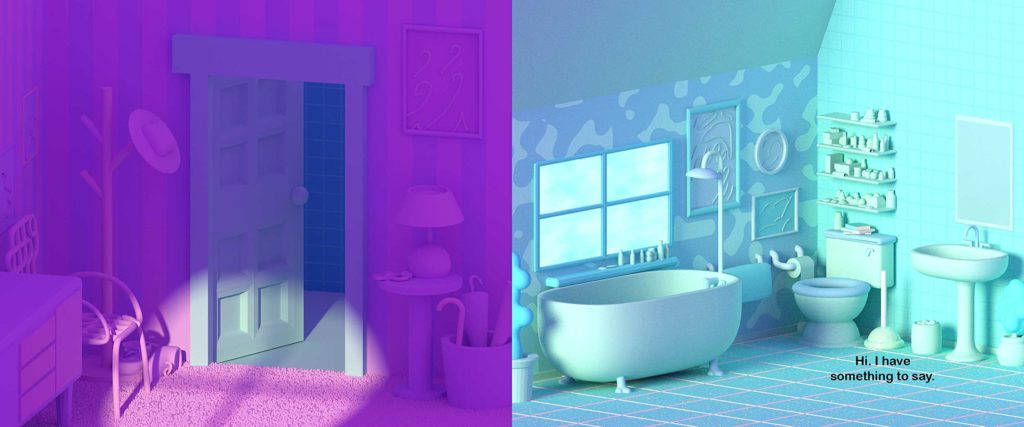
Julian Glander: Yeah, that’s really trippy.
Julio Torres: And I like it because that is when I feel like Julianne’s work achieves one of its most cinematic potentials within the book. Where we laid down the rules—which is the televisual rules—which is that Julian achieves this very uncanny quality of like you’re looking at a bathroom—and it feels like it could be a real bathroom, but not quite. Again, there’s something uncanny about it that it almost looks like a photograph. It almost looks like photographs of toys. But then, when we go to the meadow, I feel like the meadow works because the illustrations lay such a realistic bed before it. And then when that is challenged with the meadow is really exciting. And when that’s interrupted by reality, it’s also really exciting because that’s when the book really operates like a movie-like animation.
Bianca Schulze: I love the meadow scene—it’s just gorgeous.
So, I think I decided that my favorite illustration and moment is the double-page spread that shows the various household appliances and tools used in all of their unconventional or non-conventional ways, I should say. You know, like the hammer becomes a toothbrush and the hat stand becomes a toilet roll holder, you know? And that’s the moment where I feel like, you know, a kid’s mind could open and be like, oh, yeah, I really see. Like, okay, the hammer being a toothbrush is a little like, I don’t know if I really want to brush my teeth with a hammer, but let’s get creative here and let’s really think about the different things that we could be. And the other objects that I play with could become other things too.
Julio Torres: I just yeah, that page is really fun. And Julian came up with all of those, which was like a really beautiful moment of collaboration.
Julian Glander: Yeah, this one’s almost like it’s a break in everything else that’s happening in the book because a lot of these are—they’re kind of punny, like the tennis racket, spaghetti strainer—like it is a little bit of a visual pun. And I think what I like about the plunger wanting to be a vase is that it actually doesn’t make sense. You know, there’s no natural connection there. Whereas if a trashcan wanted to be a vase or a toilet wanted to be a vase, you would at least have this logical step of, well, it’s a basin. Yeah. So, I think this is a fun spread because it can get kids thinking about stuff like that. And it also—yeah, it almost feels like to me it feels like it’s not in the book. Like it’s almost like editorial. It’s something that’s just in the middle that’s maybe not even part of the story because we don’t see a lot of these guys again.
Bianca Schulze: Yeah, right. That’s why, for me, it was like such a kind of think outside the box moment.
Let’s dig in a little bit deeper to the message that we can all be whatever or whoever we set our hearts to be. And maybe we have to get creative and think outside the box. Perhaps the path to get there is not what we imagined, especially no thanks to societal pressures and vacuum types that surround us. But we truly can be whatever or whoever we want to be. And wouldn’t it be great if we could all be accepting of one another and celebrate each other’s uniqueness? Do you have thoughts on that?
Julio Torres: Yeah, I mean, I, it was also the second part of that. I felt like it was something that was very important for me to engage with that to make a book that isn’t like most kids’ stories where kids that seem to be predicated on the thought that, like you, the reader, are special and you, the reader, are the exception to the rule. And you, the reader, should work really hard to overcome the obstacles that others won’t be able to overcome. But to me, it’s that—and then look around you and see that everyone around you is also special. And they are on their own paths that also need to be supported and encouraged that you, the reader, are wonderful, but everyone around you is also wonderful. And to sort of start divorcing ourselves from this ideal of like this sort of like American dream ideal of work really hard to be the exception to the rule. And then if the people around you aren’t succeeding, it’s because they’re not special. And to be like, wait, no, everyone is special, and everyone is worthy of happiness.
Bianca Schulze: Yeah
Julian Glander: Yeah. I think for me, another thing that I loved about this story is this sense of collective action. And I think it’s so perfect for this kind of moment as adults that we find ourselves in where we have to build a new world where so many things have collapsed. And part of that means doing things together, creating a society that’s more harmonious. And like you said, with a vacuum, getting the buy-in of people who aren’t on board with it.
You know, I think what’s cool about the plunger is they arrive at the start of the book fully formed, knowing what they want to be. And by being so bold, they don’t just achieve their own goals. They inspire other people, and they work with the other appliances and household items to create something that works for everyone. Yeah, I think it’s like I think it’s a great lesson for kids as they’re entering society and they’re learning how to be social and be good to each other. Yeah, it breaks a little bit of that kind of main character mold that I think is so fascinating and brilliant.
Bianca Schulze: This all has me really curious about you, Julio. We’re talking about the plunger who wants to be a vase and, you know, I’m just curious about you as a human. Did you always want to be a comedian? Is that something that you always imagine that you would be?
Julio Torres: Yeah. I mean, I feel like the book can be interpreted in many different ways. And it can be applied to many kids, different paths, and who they’re perceived to be versus who they are or want to be. But in my case, it’s really tied to your question in that it was very informed, not even by childhood but by adolescence.
When I was like graduating high school, my parents were very broke, and I had very bad grades. And I wanted to be a creator, a writer, and the guidance counselor, not because he was mean, but because it was his job to bring reality to the conversation was like, wait, but like your grades are bad. There’s no extracurricular of any—you’re a mediocre student with broke parents. Like, I don’t think that moving to New York and pursuing these things is what you should be doing and like, encouraged me to, like, stay and find, like, a reasonable path. And again, it wasn’t malicious. It was just a vacuum being a vacuum. So that’s really what, to me, was one of the many seeds of this book.
Bianca Schulze: So, Julian, now I’m curious if being an animator is something that you always wanted to do. And I did receive a write-in question for you via Instagram, and I hope I pronounce this correctly. It was from @ besnik.kadiu. He wanted to know, when did you start having interests in 3D animation?
Julian Glander: It was pretty late, actually. I mean, I grew up loving cartoons like every child. I thought they were real. I saw Who Framed Roger Rabbit, and I thought that cartoons were made in that part of Hollywood where all the cartoons lived for a long time, till I was maybe ten or 11.
Bianca Schulze: Me, too.
Julian Glander: But I had a lot of similar kinds of guidance counselor moments. I wasn’t an especially good drawer, or I didn’t—I liked doing it, but no one ever told me I was good at it. And I started doing 3D—I think I was probably 23 or 24—I’d been out of school for a couple of years. And the reason it connected, I think, is because I had spent so much time playing with LEGOs as a kid. And unlike traditional drawing, that’s really more what it’s like. It’s like—it’s about arranging things, making choices, and combining modular pieces. So, it didn’t click together until really late for me. Yeah, I had a guidance counselor who said, Oh, you’re funny, but you’re not like that funny. So, we’re thinking you should like we’re thinking you’re funny enough to go into advertising.
Julio Torres: Brutal.
Julian Glander: So, I studied communications in school.
Julio Torres: You’re creative but not artist creative.
Julian Glander: Maybe like maybe Geico commercial. You know.
Bianca Schulze: Sometimes I like the Geico commercials, though.
Julian Glander: That’s what I thought I would end up doing, like writing stupid comedy sketches in a nice office with a foosball table for the rest of my life.
Julio Torres: Right?
Bianca Schulze: Oh, man. Well, I have a great write-in question for you, Julio. It’s from Sandra Meaders of the Life Is What It’s Called blog. And she wants to know how is writing a children’s book similar to and different from writing a sketch for something like Saturday Night Live?
Julio Torres: You know, it’s very similar with the exception of like word choice. There were a couple of moments where Julia, our wonderful editor, was like, maybe this should be simplified. It’s very; I don’t know—I feel like I really am myself regardless of context. And I didn’t want to make a kid’s book that talked down to kids. I want kids to find this book and feel like they’re getting away with something. And so, yeah, I feel like I work well with metaphor anyway, and that’s what this book is. So yeah, weirdly enough, this book is not dissimilar to something I would have tried to write for adults.
Bianca Schulze: I love that you use the word metaphor because I’m often trying to put my finger on why does a comedy sketch really speak to me or why does a particular book really speak to me? And it usually is because of a metaphor. How do you think you got to the spot where you think clearly in such a metaphorical sense? Do you feel like you always thought metaphorically, or how did that all happen for you?
Julio Torres: Yeah, I feel like that is how— I feel like more than having a specific medium, there’s a specific way that I like thinking and telling stories. And sometimes they’re a sketch; sometimes they’re a kid’s book, sometimes they’re a movie. But it’s always like idea first, medium second. And I don’t know, I feel like I don’t know how to do most things, but I do know what I like to do and that’s this. So, yeah, I feel like, well, that’s what I’m doing because I don’t know how to do anything else.
Bianca Schulze: Yeah. So, you know when you want to be a vase and you know when the flowers are blooming—and the flowers are blooming is your idea.
Julio Torres: Yes.
Bianca Schulze: Yeah. So, Julian, let me ask you, I want to go back to what you said, where you had this—you imagined what your days were going to look like. So, what do your days look like now? Like how does a workday look for you?
Julian Glander: It’s really weird. I don’t work that much anymore. I think if I can get, like, 4 hours of good focus work in a day, that’s great. Five days a week. And I’m spending a lot of time thinking and going on walks and marinating and being away from the computer. I spent a whole decade in front of the computer, and it—you know, I’ve had a great career, but it ruined my life and rotted my brain, and I didn’t experience life. So now, about a month ago, I got two ducks and my main day-to-day has been raising these ducks.
Bianca Schulze: That’s awesome. I saw Julio nodding when you use the word marinating, and listeners can’t see you nodding, Julio. So, when Julian said the word marinating, you nodded. Do you have a technique that you use when you’re marinating an idea?
Julio Torres: God no! I have no techniques for anything. I have no techniques and I have no tips. But I know what Julian said about marinating really resonated with me because so much of my life and work goes into just—yeah—thinking. And I realized that the most important, one of the most important pieces of furniture for me is a couch because I have this very like sort of Cleopatra way of working where I have to be lounging, looking out a window for me to be like thinking. The actual work of typing is truly like—feels like 5% of it.
Bianca Schulze: Yeah, I love that. I love that. I can see you on the Cleopatra couch.
All right. So let me ask you this, Julio, as the author of the book. Who do you imagine reading this book and what do you hope they take away from your story?
Julio Torres: Well, I like the idea of a kid that is sort of like—that maybe resembles who I was a child, which was very, very othered, very, very off on the corner—discovering the book and feeling, feeling seen by it or feeling like it resonates for whatever personal reason. Yeah. And I would hope that the takeaway is this idea, this like two, two-parter of I am worthy of being what I want to be or being who I am. And I wonder what others around me are going through.
Bianca Schulze: Yeah. I really like that second part, too, because it’s so easy to just think from one’s own perspective and to really think of others—just, you know, we all need to do that more.
Julian, what are your hopes that a reader will take away?
Julian Glander: Other than the ideal child or the typical target of this book. I’d like to see a 65-year-old retiring guidance counselor pick up this book, reading it to his grandkids. And he goes—he read it, he pushes the book, and he looks up, and he goes, I was wrong, and then he has to go back and reach out to every kid that the guidance counseled and make it right and set them on the right path in life, which is their personal path.
Bianca Schulze: Yeah.
Julio Torres: Yeah. I was going to say for the 65-year-old retired guidance counselor to pick up the book and be like, wait, I want to go into dancing.
Julian Glander: I was going to say, belly dancer. That’s crazy.
Julio Torres: Yeah. And have this whole new life.
Bianca Schulze: Yeah.
Julian Glander: It’s never too late. Yeah.
Bianca Schulze: Oh, gosh, that’s brilliant. All right. So, I just want to thank you both so much for coming on today. And I wanted to say that the plunger in me sees the plunger in you and may all the picture book readers out there embrace their inner plunger, too. So, thanks, guys.
Julian Glander: Thank you, Bianca.
Julio Torres: Bye, Bianca. Bye, Julian.
Bianca Schulze: Bye.
About the Book

I Want to Be a Vase
Written by Julio Torres
Illustrated by Julian Glander
Ages 4+ | 48 Pages
Publisher: Atheneum Books for Young Readers | ISBN-13: 978-1534493902
Publisher’s Synopsis: Former SNL writer and comedic rising star Julio Torres takes readers on a journey through the lives and intimate dramas of some of the unsung shapes of our time in this picture book inspired by his HBO special My Favorite Shapes.
Shapes. You’ve heard of them. You might have even interacted with a few. But do you really know them? From plucky Plunger, who wishes to defy his shape and become a beautiful vase, to other household objects with dreams of a life beyond their predestined roles, I Want to Be a Vase takes readers on an essential and visually stunning journey through the lives and intimate dramas of often-overlooked household appliances.
Buy the Book
Show Notes
Visit Julio Torres on Instagram @SpacePrinceJulio.
Visit Julian Glander at Glander.co.
HBO special My Favorite Shapes.
Thank you for listening to the Growing Readers Podcast episode: Bianca with Julio Torres and Julian Glander on I Want to Be a Vase. For the latest episodes from The Growing Readers Podcast, Follow Now on Spotify. For similar books and articles, you can check out all of our content tagged with Books About Identity and Picture Books.

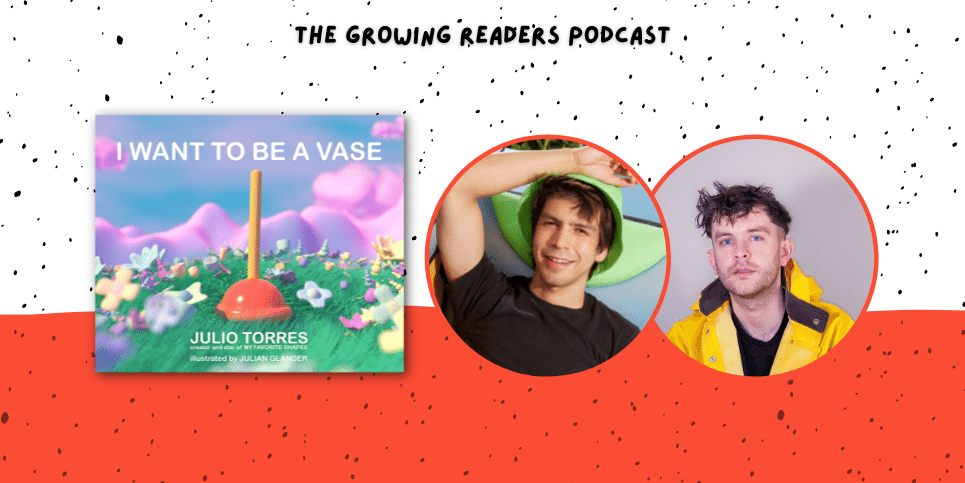
2 Comments
Very fun story. Children enjoy these stuff alot.
Propaganda starting at 4